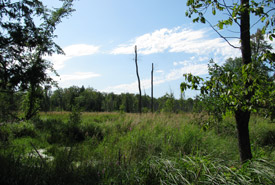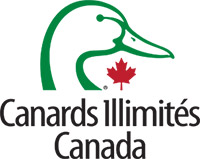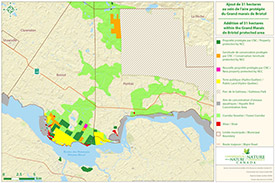Bristol and Clarendon - Protecting the wetlands and forests

Wetland and forest protected by NCC in Bristol, Quebec (Photo by NCC)
Since 2004, the Nature Conservancy of Canada (NCC) has been investing in the conservation of two priority areas in the Ottawa Valley: Bristol and Clarendon.
These areas include large tracts of wetlands, forests and unspoiled shorelines, as well as some of the most beautiful alvars in Quebec. Thanks to the participation of several partners, NCC protects more than 2,500 hectares (6,177 acres) of high ecological value.
The Ottawa Valley features some of the richest biodiversity in the province, including large populations of Blanding’s, musk and map turtles. Some 110 species of breeding birds also make their home there, as well as several species of waterfowl. NCC detected the presence of a large number of Canada geese, red-winged blackbirds, blue jays, Americain robins and red-eyed vireos, well as less common species, such as Virginia rail, pied-billed grebe and sora. The team also heard a great blue heron nesting high up in a swamp.
As night fell, team members saw bats fluttering near the treetops. Through the choirs of the frogs, the presence of Wilson's snipe, Americain bittern, common loon, swamp sparrow and black-crowned night-heron was also detected.
The Ottawa Valley’s flora is as remarkable as its fauna; about 30 species of plants and trees in a precarious situation are found there.
Through inventory, species monitoring, and the help of volunteers, NCC expanded its knowledge and discovered that one bird species, woodcock, is threatened in Canada and likely to be designated as threatened or vulnerable in Quebec.
Recently, about 10 volunteers joined the Nature Conservancy of Canada (NCC) team to inventory and monitor these species.
One of the species, the eastern whip-poor-will, is designated threatened in Canada and likely to be designated threatened or vulnerable in Quebec.
Greater Bristol Marsh
Within the Greater Bristol Marsh area, there is an important ecological corridor which NCC aims to consolidate.
An ecological corridor is a natural land or water passage linking natural areas together, allowing wildlife to move around and flora to disperse. Maintaining ecological corridors between natural environments helps prevent species loss; the chances of animals and plants being isolated from their natural habitat due to, for example, human infrastructure, are reduced.
“We are conserving more than 1,140 hectares (2817 acres) in a large natural corridor that stretches from the Ottawa River to Gatineau Park,’’ says Caroline Gagné, NCC’s program director for western Quebec. ‘‘We need to ensure that the forests and wetlands we conserve are connected to each other. Species with large home ranges, such as white-tailed deer, which frequent the Ottawa Valley, need large wilderness areas for feeding and breeding.”
(Click on the image to enlarge)
Partners
NCC would like to acknowledge the contribution of our partners in these projects:






We also extend our warmest thanks to the Muirhead, Connelly and Lamarche families, who supported NCC in our conservation mission.





